ISSUER FREE WRITING PROSPECTUS Filed Pursuant to Rule 433 Registration Statement No. 333-134553 Dated March 6, 2008 |  |
100% Principal Protection Absolute Return Barrier Notes
Linked to a Basket of Global Indices
Investment Strategies for Uncertain Markets
Lehman Brothers Holdings Inc. Notes Linked to a Basket of Global Indices due
September 30, 2009
Investment Description
The 100% Principal Protection Absolute Return Barrier Notes Linked to a Basket of Global Indices (the “Notes”) provide an opportunity to potentially hedge your exposure to equity securities as represented by the S&P 500® Index, the Russell 2000® Index, the MSCI EAFE Index®, the Dow Jones EURO STOXX 50® Index and the NASDAQ-100 Index® (each, a “Basket Index” and, collectively, the “Basket Indices”), while benefiting from moderately positive or negative returns of the Basket. If the Basket Closing Level is not more than 17.75% to 20.75% (to be determined on the Trade Date and to which percentage we refer as the “Absolute Return Barrier”), above or below the Basket Starting Level on any trading day during the Observation Period, at maturity you will receive your principal plus a return equal to the absolute value of the Basket return. Otherwise, at maturity you will receive only your principal.
Features
| q | Hedging Opportunity — You have the potential to hedge your exposure to the Basket Indices while benefiting from moderately positive or negative returns over the 18-month term of the Notes. |
| q | Potential for Equity-Linked Performance — If the Basket Closing Level is never more than 17.75% to 20.75% (to be determined on the Trade Date) above or below the Basket Starting Level on any trading day during the Observation Period, you will receive an equity-based return that may exceed the return you could receive on traditional fixed income investments. |
| q | Preservation of Capital — At maturity, you will receive a cash payment equal to at least 100% of your principal. |
Key Dates1
Trade Date | March 25, 2008 | |
Settlement Date | March 31, 2008 | |
Final Valuation Date | September 25, 2009 | |
Maturity Date | September 30, 2009 |
1 | The Notes are expected to trade on or about March 25, 2008 and settle on or about March 31, 2008. In the event we make any change to the expected Trade Date and Settlement Date, the Final Valuation Date and Maturity Date will be changed so that the stated term of the Notes remains the same. |
Security Offerings
We are offering 100% Principal Protection Absolute Return Barrier Notes Linked to a Basket of Global Indices. The Notes are linked to a basket of indices (the “Basket”) consisting of the S&P 500® Index, the Russell 2000® Index, the MSCI EAFE Index®, the Dow Jones EURO STOXX 50® Index and the NASDAQ-100 Index®. The Notes are offered at a minimum initial investment of $1,000 in denominations of $10 and integral multiples thereof.
See “Additional Information about Lehman Brothers Holdings Inc. and the Notes” on page 2. The Notes offered will have the terms specified in the base prospectus dated May 30, 2006, the MTN prospectus supplement dated May 30, 2006, product supplement no. 1020-I dated March 6, 2008, underlying supplement no. 1190 dated March 5, 2008 and this term sheet. See “Key Risks” on page 6, the more detailed “Risk Factors” beginning on page SS-1 of product supplement no. 1020-I for risks related to an investment in the Notes, and “Risk Factors” beginning on page US-1 of underlying supplement no. 1190 for risks related to the Basket Indices.
Neither the Securities and Exchange Commission nor any state securities commission has approved or disapproved of the Notes or passed upon the accuracy or the adequacy of this term sheet, the accompanying base prospectus, MTN prospectus supplement, product supplement no. 1020-I, underlying supplement no. 1190 or any other related prospectus supplements, or any other relevant terms supplement. Any representation to the contrary is a criminal offense. The Notes are not deposit liabilities of Lehman Brothers Holdings Inc. and are not FDIC-insured.
Price to Public | Underwriting Discount | Proceeds to Us | ||||
Per Note | $10.00 | $0.175 | $9.825 | |||
Total |
UBS Financial Services Inc. | Lehman Brothers Inc. |
Additional Information about Lehman Brothers Holdings Inc. and the Notes
Lehman Brothers Holdings Inc. has filed a registration statement (including a base prospectus) with the U.S. Securities and Exchange Commission, or SEC, for this offering. Before you invest, you should read this term sheet together with the base prospectus, as supplemented by the MTN prospectus supplement relating to our Series I medium-term notes of which the Notes are a part, and the more detailed information contained in product supplement no. 1020-I (which supplements the description of the general terms of the Notes) and underlying supplement no. 1190 (which describes the Basket Indices, including risk factors specific to each). Buyers should rely upon the base prospectus, the MTN prospectus supplement, product supplement no. 1020-I, underlying supplement no. 1190, this term sheet, any other relevant terms supplement and any other relevant free writing prospectus for complete details. To the extent that there are any inconsistencies among the documents listed below, this term sheet shall supersede product supplement no. 1020-I, which shall, likewise, supersede the base prospectus and the MTN prospectus supplement. You should carefully consider, among other things, the matters set forth in “Risk Factors” in the accompanying product supplement no. 1020-I and “Risk Factors” in the accompanying underlying supplement no. 1190, as the Notes involve risks not associated with conventional debt securities. We urge you to consult your investment, legal, tax, accounting and other advisors before you invest in the Notes. You may get these documents and other documents Lehman Brothers Holdings Inc. has filed for free by searching the SEC online database (EDGAR®) at www.sec.gov, with “Lehman Brothers Holdings Inc.” as a search term or through the links below, or by calling UBS Financial Services Inc. toll-free at 1-877-827-2010 or Lehman Brothers Inc. toll-free at 1-888-603-5847.
You may access these documents on the SEC website at www.sec.gov as follows (or if such address has changed, by reviewing our filings for the relevant date on the SEC website):
| ¨ | Product supplement no. 1020-I dated March 6, 2008: |
http://www.sec.gov/Archives/edgar/data/806085/000119312508048988/d424b2.htm
| ¨ | Underlying supplement no. 1190 dated March 5, 2008: |
http://www.sec.gov/Archives/edgar/data/806085/000119312508046540/d424b2.htm
| ¨ | MTN Prospectus supplement dated May 30, 2006: |
http://www.sec.gov/Archives/edgar/data/806085/000104746906007785/a2170815z424b2.htm
| ¨ | Base Prospectus dated May 30, 2006: |
http://www.sec.gov/Archives/edgar/data/806085/000104746906007771/a2165526zs-3asr.htm
References to “Lehman Brothers,” “we,” “our” and “us” refer only to Lehman Brothers Holdings Inc. and not to its consolidated subsidiaries. In this document, “Notes” refers to the 100% Principal Protection Absolute Return Barrier Notes Linked to a Basket of Global Indices that are offered hereby, unless the context otherwise requires.
Investor Suitability
The Notes may be suitable for you if, among other considerations:
| ¨ | You seek an investment that offers 100% principal protection when the Notes are held to maturity |
| ¨ | You believe that the Basket will appreciate or depreciate over the Observation Period and that any appreciation or depreciation is unlikely to exceed the Upper or Lower Basket Barrier on any trading day during the Observation Period |
| ¨ | You are willing to hold the Notes to maturity |
| ¨ | You do not seek current income from this investment |
| ¨ | You are willing to invest in securities for which there may be little or no secondary market |
| ¨ | You are willing to forgo dividends paid on the stocks included in the Basket Indices |
The Notes may not be suitable for you if, among other considerations:
| ¨ | You believe the Basket Closing Level is likely to rise or fall over the Observation Period and that any such rise or fall is likely to exceed the Upper Basket Barrier or Lower Basket Barrier on one or more trading days during the Observation Period |
| ¨ | You are unable or unwilling to hold the Notes to maturity |
| ¨ | You prefer the lower risk, and therefore accept the potentially lower returns, of fixed income investments with comparable maturities and credit ratings |
| ¨ | You seek current income from your investments |
| ¨ | You seek an investment for which there will be an active secondary market |
The suitability considerations identified above are not exhaustive. Whether or not the Notes are a suitable investment for you will depend on your individual circumstances, and you should reach an investment decision only after you and your investment, legal, tax, accounting and other advisors have carefully considered the suitability of an investment in the Notes in light of your particular circumstances. You should also review carefully the “Key Risks” on page 7, “Risk Factors” in product supplement no. 1020-I, underlying supplement no. 1190 and the MTN prospectus supplement for risks related to an investment in the Notes.
2
Indicative Terms
Issuer | Lehman Brothers Holdings Inc. (A+/A1/AA-)1 | |||
Issue Price | $10 per Note | |||
Term | 18 months | |||
Basket | The Notes are linked to a basket consisting of the S&P 500® Index (SPX), the Russell 2000® Index (RTY), the MSCI EAFE Index® (MXEA), the Dow Jones EURO STOXX 50® Index (SX5E) and the NASDAQ-100 Index® (NDX) (each, a “Basket Index” and, collectively, the “Basket Indices”). | |||
Basket Index Weightings | S&P 500® Index | 40% | ||
Russell 2000® Index | 20% | |||
MSCI EAFE Index® | 20% | |||
Dow Jones EURO STOXX 50® Index 10% | ||||
NASDAQ-100 Index® | 10% | |||
Principal Protection | 100% if held to maturity | |||
Payment at Maturity (per $10 principal amount Note) | If the Basket Closing Level on any trading day during the Observation Period is not above the Upper Basket Barrier or below the Lower Basket Barrier, you will receive a cash payment, for each $10 principal amount Note, equal to: | |||
$10 + ($10 × Absolute Basket Return) | ||||
If the Basket Closing Level on any trading day during the Observation Period is above the Upper Basket Barrier or below the Lower Basket Barrier, you will receive a cash payment of $10 for each $10 principal amount Note. | ||||
Absolute Basket Return | Absolute value of: Basket Ending Level - Basket Starting Level | |||
Basket Starting Level | ||||
Basket Starting Level | Set equal to 100 on the Trade Date. | |||
Basket Ending Level | The Basket Closing Level on the Final Valuation Date. | |||
Basket Closing Level | As to any trading day: 100 × [1+ (the S&P 500® Index Return × 40%) + (the Russell 2000® Index Return × 20%) + (the MSCI EAFE Index® Return × 20%) + (the Dow Jones EURO STOXX 50® Index Return × 10%) + (the NASDAQ-100 Index® Return × 10%)] | |||
The “S&P 500® Index Return,” the “Russell 2000® Index Return,” the “MSCI EAFE Index® Return,” the “Dow Jones EURO STOXX 50® Index Return” and the “NASDAQ-100 Index® Return” represent, as to a given trading day, the performance of the respective Basket Indices, calculated, in each case, as the percentage change from the related index closing level on the Trade Date to the related index closing level on such trading day. See the definition of “Index Return” under “Description of Notes—Payment at Maturity” in the accompanying product supplement no. 1020-I. | ||||
Observation Period | The period starting on (but excluding) the Trade Date and ending on (and including) the Final Valuation Date. | |||
Absolute Return Barrier | 17.75% to 20.75%. The actual Absolute Return Barrier will be determined on the Trade Date. | |||
Upper Basket Barrier | Basket Starting Level × (1 + Absolute Return Barrier) | |||
Lower Basket Barrier | Basket Starting Level × (1 - Absolute Return Barrier) | |||
CUSIP | 52522L830 | |||
ISIN | US52522L8303 | |||
Determining Payment at Maturity |
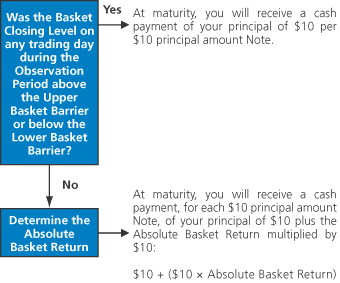
1 | Lehman Brothers Holdings Inc. is rated A+ by Standard & Poor’s, A1 by Moody’s and AA- by Fitch. A credit rating reflects the creditworthiness of Lehman Brothers Holdings Inc. and is not a recommendation to buy, sell or hold securities, and it may be subject to revision or withdrawal at any time by the assigning rating organization. Each rating should be evaluated independently of any other rating. The creditworthiness of the issuer does not affect or enhance the likely performance of the investment other than the ability of the issuer to meet its obligations. |
3
Scenario Analysis and Examples at Maturity
The following examples and table illustrate the Payment at Maturity for a $10 principal amount Note on a hypothetical offering of the Notes, with the following assumptions:
| Principal Amount: | $10.00 | |
| Basket Starting Level: | 100.00 | |
| Principal Protection: | 100% at maturity | |
| Term: | 18 months | |
| Absolute Return Barrier: | 19.25%* (the midpoint of the range of 17.75% to 20.75%) | |
| Upper Basket Barrier: | 119.25, which is 19.25% above the Basket Starting Level* | |
| Lower Basket Barrier: | 80.75, which is 19.25% below the Basket Starting Level* | |
| Observation Period: | The period starting on, but excluding, the Trade Date and ending on, and including, the Final Valuation Date. |
| * | The actual Absolute Return Barrier, Upper Basket Barrier and Lower Basket Barrier for the Notes will be set on the Trade Date. |
| Hypothetical Performance of the Notes | ||||||||||||||
| Hypothetical Basket Ending Level | Hypothetical Basket | The Basket Closing Level is Never Outside Absolute Return Barrier* | The Basket Closing Level is Outside Absolute Return Barrier** | |||||||||||
| Additional Amount at Maturity ($) | Payment at Maturity ($) | Return on Note (%) | Additional Amount at Maturity ($) | Payment at Maturity ($) | Return on Note (%) | |||||||||
| 200.00 | 100.00% | N/A | N/A | N/A | $0.00 | $10.00 | 0.00% | |||||||
| 180.00 | 80.00% | N/A | N/A | N/A | $0.00 | $10.00 | 0.00% | |||||||
| 160.00 | 60.00% | N/A | N/A | N/A | $0.00 | $10.00 | 0.00% | |||||||
| 140.00 | 40.00% | N/A | N/A | N/A | $0.00 | $10.00 | 0.00% | |||||||
| 120.00 | 20.00% | N/A | N/A | N/A | $0.00 | $10.00 | 0.00% | |||||||
| 119.25 | 19.25% | $1.93 | $11.93 | 19.25% | $0.00 | $10.00 | 0.00% | |||||||
| 119.00 | 19.00% | $1.90 | $11.90 | 19.00% | $0.00 | $10.00 | 0.00% | |||||||
| 110.00 | 10.00% | $1.00 | $11.00 | 10.00% | $0.00 | $10.00 | 0.00% | |||||||
| 100.00 | 0.00% | $0.00 | $10.00 | 0.00% | $0.00 | $10.00 | 0.00% | |||||||
| 90.00 | -10.00% | $1.00 | $11.00 | 10.00% | $0.00 | $10.00 | 0.00% | |||||||
| 81.00 | -19.00% | $1.90 | $11.90 | 19.00% | $0.00 | $10.00 | 0.00% | |||||||
| 80.75 | -19.25% | $1.93 | $11.93 | 19.25% | $0.00 | $10.00 | 0.00% | |||||||
| 80.00 | -20.00% | N/A | N/A | N/A | $0.00 | $10.00 | 0.00% | |||||||
| 60.00 | -40.00% | N/A | N/A | N/A | $0.00 | $10.00 | 0.00% | |||||||
| 40.00 | -60.00% | N/A | N/A | N/A | $0.00 | $10.00 | 0.00% | |||||||
| 20.00 | -80.00% | N/A | N/A | N/A | $0.00 | $10.00 | 0.00% | |||||||
| 0.00 | -100.00% | N/A | N/A | N/A | $0.00 | $10.00 | 0.00% | |||||||
| * | Calculation assumes that the Basket Closing Level is never above the Upper Basket Barrier or below the Lower Basket Barrier on any trading day during the Observation Period |
| ** | Calculation assumes that the Basket Closing Level is above the Upper Basket Barrier or below the Lower Basket Barrier on at least one trading day during the Observation Period |
Example 1: On a trading day during the Observation Period, the Basket Closing Level was 140.00, which is 40% above the Basket Starting Level, and the Basket Ending Level is 19% above the Basket Starting Level.Since the Basket Closing Level was above the Upper Basket Barrier, you will receive a Payment at Maturity of $10.00 per $10 principal amount Note.
Example 2: During the Observation Period, the Basket Closing Level was never above the Upper Basket Barrier or below the Lower Basket Barrier and the Basket Ending Level is 10% above the Basket Starting Level. You will receive a Payment at Maturity of $11.00 per $10 principal amount Note.
Example 3: On a trading day during the Observation Period, the Basket Closing Level was 60.00, which is 40% below the Basket Starting Level, and the Basket Ending Level is 19% below the Basket Starting Level. Since the Basket Closing Level was below the Lower Basket Barrier, you will receive a Payment at Maturity of $10.00 per $10 principal amount Note.
Example 4: During the Observation Period, the Basket Closing Level was never above the Upper Basket Barrier or below the Lower Basket Barrier and the Basket Ending Level is 10% below the Basket Starting Level. You will receive a Payment at Maturity of $11.00 per $10 principal amount Note.
4
What are the tax consequences of the Notes?
Lehman Brothers Holdings Inc. intends to treat, and by purchasing a Note, for all tax purposes, you agree to treat, a Note as debt subject to the contingent payment debt instrument rules. Lehman Brothers Holdings Inc. is required to provide the comparable yield to you and, solely for tax purposes, is also required to provide a projected payment schedule that includes the fixed payments on the Notes and estimates of the amount and timing of the contingent payments on the Notes. Lehman Brothers Holdings Inc. has determined that the comparable yield will be an annual rate of [ ]%, compounded semi-annually. Based on the comparable yield, the projected payment schedule per $10 principal amount Note is $[ ] due at maturity.
Lehman Brothers Holdings Inc. agrees and, by purchasing a Note, you agree, for United States federal income tax purposes, to be bound by Lehman Brothers Holdings Inc.’s determination of the comparable yield and projected payment schedule. As a consequence, for United States federal income tax purposes, you must use the comparable yield determined by Lehman Brothers Holdings Inc. and the projected payments set forth in the projected payment schedule prepared by Lehman Brothers Holdings Inc. in determining your interest accruals (even though you will not receive any periodic payments of interest on the Notes), and the adjustments thereto, in respect of the Notes.
If the Payment at Maturity differs from the projected contingent payment, an adjustment will be made for the difference. A positive adjustment, for the amount by which the Payment at Maturity exceeds the projected contingent payment, will be treated as additional original issue discount in the year such Payment at Maturity is received. A negative adjustment, for the amount by which the projected contingent payment exceeds the Payment at Maturity, will, first, reduce the amount of original issue discount required to be accrued with respect to the Note in the year such Payment at Maturity is received, and second, any negative adjustment that exceeds the amount of original issue discount accrued with respect to the Note in the year such Payment at Maturity is received will be treated as ordinary loss, that is not subject to the limitations applicable to miscellaneous itemized deductions under Section 67 of the Internal Revenue Code of 1986, as amended, to the extent of your total prior original issue discount inclusions with respect to the Note. Notwithstanding the foregoing, special rules will apply if the Payment at Maturity becomes fixed more than six months prior to its scheduled date of payment. See “Certain U.S. Federal Income Tax Consequences—Notes with a Term of More Than One Year—Accrual of interest” in the accompanying product supplement 1020-I.
See “Certain U.S. Federal Income Tax Consequences” in the accompanying product supplement no. 1020-I.
5
Key Risks
An investment in the Notes involves significant risks. Investing in the Notes is not equivalent to investing directly in any of the stocks included in the Basket Indices. These risks are explained in more detail in the “Risk Factors” section of the accompanying product supplement no. 1020-I and in the “Risk Factors” section of the accompanying underlying supplement no. 1190. You should reach an investment decision only after you have carefully considered with your advisors the suitability of an investment in the Notes in light of your particular circumstances.
| ¨ | No Principal Protection Unless You Hold the Notes To Maturity—The Notes are not designed to be short-term trading instruments. You will receive at least the minimum payment of 100% of the principal amount of your Notes if you hold your Notes to maturity. If you sell your Notes in the secondary market prior to maturity, you will not receive principal protection. YOU SHOULD BE WILLING TO HOLD YOUR NOTES TO MATURITY. |
| ¨ | Market Risk—Amounts payable on the Notes and their market value will depend on the performance of the Basket and will depend on the Basket Closing Level during the Observation Period. YOU WILL RECEIVE NO MORE THAN THE FULL PRINCIPAL AMOUNT OF YOUR NOTES AT MATURITY IF THE BASKET CLOSING LEVEL IS EITHER ABOVE THE UPPER BASKET BARRIER OR BELOW THE LOWER BASKET BARRIER ON ONE OR MORE TRADING DAYS DURING THE OBSERVATION PERIOD. |
| ¨ | The Notes Might Not Pay More Than the Principal Amount—You may receive a lower Payment at Maturity than you would receive by investing in any of the stocks underlying the Basket Indices or in contracts related to the Basket Indices. If the Basket Ending Level is above the Basket Starting Level but the Basket Closing Level is above the Upper Basket Barrier or below the Lower Basket Barrier on one or more trading days during the Observation Period, you will receive only the principal amount of your Notes. |
| ¨ | The Absolute Return Barrier Limits Your Potential Return—The appreciation potential of the Notes is limited to the Absolute Return Barrier of 17.75% to 20.75% (to be determined on the Trade Date), regardless of the performance of the Basket. |
| ¨ | No Interest or Dividend Payments or Voting Rights—As a holder of the Notes, you will not receive interest payments, and you will not have voting rights or rights to receive cash dividends or other distributions or other rights that holders of stocks underlying the Basket Indices would have. |
| ¨ | Certain Built-in Costs are Likely to Adversely Affect the Value of the Notes Prior to Maturity—While the Payment at Maturity described in this term sheet is based on the full principal amount of your Notes, the original issue price of the Notes includes the agent’s commission and the cost of hedging our obligations under the Notes through one or more of our affiliates, which includes our affiliates’ expected cost of providing such hedge as well as the profit our affiliates expect to realize in consideration for assuming the risks inherent in providing such hedge. As a result, the price, at which Lehman Brothers Inc. will be willing to purchase Notes from you in secondary market transactions, if at all, will likely be lower than the original issue price and any sale prior to the Maturity Date could result in a substantial loss to you. The Notes are not designed to be short-term trading instruments. YOU SHOULD BE WILLING TO HOLD YOUR NOTES TO MATURITY. |
¨ | We Are One of the Companies That Make Up the S&P 500® Index—We are one of the companies that make up the S&P 500® Index. We will not have any obligation to consider your interests as a holder of the Notes in taking any corporate action that might affect the level of the S&P 500® Index and the value of the Notes. |
| ¨ | Dealer Incentives—We, our affiliates and agents act in various capacities with respect to the Notes. Lehman Brothers Inc. and other of our affiliates may act as a principal, agent or dealer in connection with the Notes. Such affiliates, including the sales representatives, will derive compensation from the distribution of the Notes and such compensation may serve as an incentive to sell the Notes instead of other investments. We will pay compensation of $0.175 per $10 principal amount Note to the principals, agents and dealers in connection with the distribution of the Notes. |
| ¨ | Lack of Liquidity—The Notes will not be listed on any securities exchange. Lehman Brothers Inc. intends to offer to purchase the Notes in the secondary market but is not required to do so. Even if there is a secondary market, it may not provide enough liquidity to allow you to trade or sell the Notes easily. Because other dealers are not likely to make a secondary market for the Notes, the price at which you may be able to trade your Notes is likely to depend on the price, if any, at which Lehman Brothers Inc. is willing to buy the Notes. If you are an employee of Lehman Brothers Holdings Inc. or one of our affiliates, you may not be able to purchase the Notes from us and your ability to sell or trade the Notes in the secondary market may be limited. |
| ¨ | Potential Conflicts—We and our affiliates play a variety of roles in connection with the issuance of the Notes, including acting as calculation agent and hedging our obligations under the Notes. In performing these duties, the economic interests of the calculation agent and other affiliates of ours are potentially adverse to your interests as an investor in the Notes. |
| ¨ | We and Our Affiliates and Agents May Publish Research, Express Opinions or Provide Recommendations that Are Inconsistent with Investing in or Holding the Notes. Any Such Research, Opinions or Recommendations Could Affect the Level of the Basket or the Value of the Notes—We, our affiliates and agents publish research from time to time on financial markets and other matters that may influence the value of the Notes, or express opinions or provide recommendations that may be inconsistent with purchasing or holding the Notes. We, our affiliates and agents may publish or may have published research or other opinions that are inconsistent with an investment position in the Basket. Any research, opinions or recommendations expressed by us, our affiliates or agents may not be consistent with each other and may be modified from time to time without notice. Additionally, UBS Financial Services Inc. and its affiliates may publish or may have published research and other opinions that are inconsistent with an investment position in the Basket. Investors should make their own independent investigation of the merits of investing in the Notes. |
| ¨ | Many Economic and Market Factors Will Impact the Value of the Notes—In addition to the level of the Basket on any day, the value of the Notes will be affected by a number of economic and market factors that may either offset or magnify each other and which are set out in more detail in product supplement no. 1020-I. |
| ¨ | Tax Treatment—You should consider the tax consequences of investing in the Notes and consult your own tax advisor about your own tax situation before investing in the Notes. |
| ¨ | Creditworthiness of Issuer—An investment in the Notes will be subject to the credit risk of Lehman Brothers Holdings Inc., and the actual and perceived creditworthiness of Lehman Brothers Holdings Inc. may affect the market value of the Notes. |
6
Hypothetical Historical Basket Performance
The graph below illustrates the hypothetical historical performance of the Basket from February 26, 1998 to February 26, 2008, if the level of the Basket was made to equal 100 on February 26, 2008. The hypothetical historical performance reflects the performance the Basket would have exhibited based on (i) the actual historical performance of the Basket Indices and (ii) the Basket Index Weightings indicated under “Indicative Terms” above. Neither the hypothetical historical performance of the Basket nor the actual historical performance of the Basket Indices should be taken as indications of future performance.
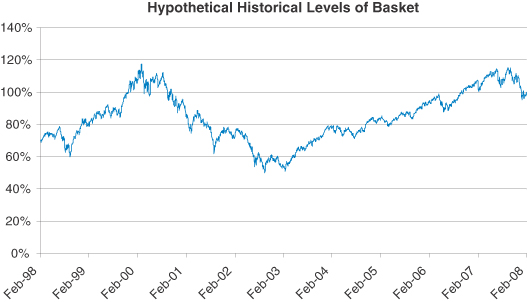
Source: Lehman Brothers Inc.
S&P 500® Index
The S&P 500® Index is published by Standard & Poor’s (“S&P”), a division of The McGraw-Hill Companies, Inc. As discussed more fully in underlying supplement no. 1190 under the heading “The S&P 500® Index”, the S&P 500® Index is intended to provide a performance benchmark for the U.S. equity markets. The calculation of the value of the S&P 500® Index is based on the relative value of the aggregate market value of the common stocks of 500 companies as of a particular time compared to the aggregate average market value of the common stocks of 500 similar companies during the base period of the years 1941 through 1943. Ten main groups of companies comprise the S&P 500® Index, along with the number of companies included in each group as of January 31, 2008 are indicated below: Consumer Discretionary (87); Consumer Staples (39); Energy (36); Financials (92); Health Care (51); Industrials (56); Information Technology (71); Materials (28); Telecommunications Services (9); and Utilities (31).
You can obtain the level of the S&P 500® Index at any time from the Bloomberg Financial Markets page “SPX <Index> <GO>“ or from the S&P website at www.standardandpoors.com.
The graph below illustrates the performance of the S&P 500® Index from February 26, 1998 to February 26, 2008. The historical levels of the S&P 500® Index should not be taken as an indication of future performance.
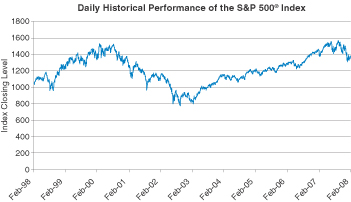
Source: Bloomberg L.P.
The S&P 500® Index closing level on February 26, 2008 was 1,381.29.
The information on the S&P 500® Index provided in this document should be read together with the discussion under the heading “The S&P 500® Index” beginning on page US-6 of underlying supplement no. 1190. Information contained in the S&P website referenced above is not incorporated by reference in, and should not be considered a part of, this free writing prospectus.
7
Russell 2000® Index
The Russell 2000® Index is calculated, maintained, published and disseminated by Russell Investment Group (“Russell”). As discussed more fully in underlying supplement no. 1190 under the heading “The Russell 2000® Index”, the Russell 2000® Index is designed to track the performance of the small capitalization segment of the U.S. equity market. The 2,000 stocks included in the Russell 2000® Index consists of the smallest 2,000 companies included in the Russell 3000® Index. A current list of the issuers that comprise the Russell 2000® Indexis available on the Russell website at www.russell.com.
You can obtain the level of the Russell 2000® Index at any time from the Bloomberg Financial Markets page “RTY <Index> <GO>“ or from the Russell website at www.russell.com.
The graph below illustrates the performance of the Russell 2000® Index from February 26, 1998 to February 26, 2008. The historical levels of the Russell 2000® Index should not be taken as an indication of future performance.
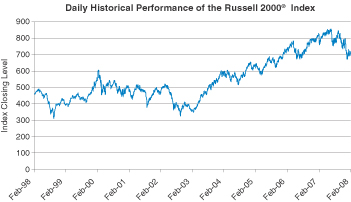
Source: Bloomberg L.P.
The Russell 2000® Index closing level on February 26, 2008 was 717.32.
The information on the Russell 2000® Index provided in this document should be read together with the discussion under the heading “The Russell 2000® Index” beginning on page US-11 of underlying supplement no. 1190. Information contained in the Russell website referenced above is not incorporated by reference in, and should not be considered a part of, this free writing prospectus.
MSCI EAFE Index®
The MSCI EAFE Index® is published by Morgan Stanley Capital International Inc. (“MSCI”). As discussed more fully in underlying supplement no. 1190 under the heading “The MSCI EAFE Index®”, the MSCI EAFE Index® is intended to provide a performance benchmark for selected developed equity markets in Europe, Asia, Australia and the Far East. The calculation of the value of the MSCI EAFE Index® is a free float weighted average of the U.S. dollar values of all the equity securities constituting the MSCI indices for 21 selected countries. As of November 27, 2007, the identity and country weight of the five largest countries represented in the Index are as follows: United Kingdom (22.24%), Japan (20.61%), France (10.45%), Germany (8.84%) and Australia (6.60%).
You can obtain the level of the MSCI EAFE Index® at any time from the Bloomberg Financial Markets page “MXEA <Index> <GO>“ or from the MSCI website at www.mscibarra.com.
The graph below illustrates the performance of the MSCI EAFE Index® from February 26, 1998 to February 26, 2008. The historical levels of the MSCI EAFE Index® should not be taken as an indication of future performance.
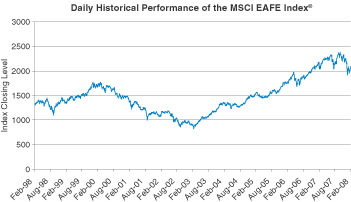
Source: Bloomberg L.P.
The MSCI EAFE Index® closing level on February 26, 2008 was 2,086.12.
The information on the MSCI EAFE Index® provided in this document should be read together with the discussion under the heading “The MSCI EAFE Index®” beginning on page US-15 of underlying supplement no. 1190. Information contained in the MSCI website referenced above is not incorporated by reference in, and should not be considered a part of, this free writing prospectus.
8
Dow Jones EURO STOXX 50® Index
The Dow Jones EURO STOXX 50® Index was created by STOXX Limited, a joint venture between Deutsche Börse AG, Dow Jones & Company, Inc. and SWX Group. As discussed more fully in underlying supplement no. 1190 under the heading “The Dow Jones EURO STOXX 50® Index”, the Dow Jones EURO STOXX 50® Index is composed of 50 component stocks of market sector leaders from within the Dow Jones EURO STOXX 50® Index, which includes stocks selected from the Eurozone. The component stocks have a high degree of liquidity and represent the largest companies across all market sectors defined by the Dow Jones Global Classification Standard. Changes in the composition of the Dow Jones EURO STOXX 50® Index are made annually to ensure that the Dow Jones EURO STOXX 50® Index includes the 50 market sector leaders from within the Dow Jones EURO STOXX 50® Index. A current list of the issuers that comprise the Dow Jones EURO STOXX 50® Index is available on the STOXX Limited website at www.stoxx.com.
You can obtain the level of the Dow Jones EURO STOXX 50® Index at any time from the Bloomberg Financial Markets page “SX5E <Index> <GO>“ or from the STOXX Limited website at www.stoxx.com.
The graph below illustrates the performance of the Dow Jones EURO STOXX 50® Index from February 26, 1998 to February 26, 2008. The historical levels of the Dow Jones EURO STOXX 50® Index should not be taken as an indication of future performance.
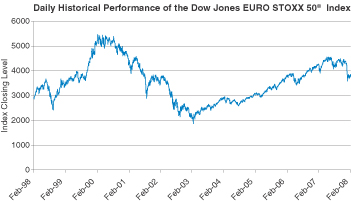
Source: Bloomberg L.P.
The Dow Jones EURO STOXX 50® Index closing level on February 26, 2008 was 3,855.03.
The information on the Dow Jones EURO STOXX 50® Index provided in this document should be read together with the discussion under the heading “The Dow Jones EURO STOXX 50® Index” beginning on page US-21of underlying supplement no. 1190. Information contained in the STOXX Limited website referenced above is not incorporated by reference in, and should not be considered a part of, this free writing prospectus.
NASDAQ-100 Index®
The Nasdaq-100 Index® is calculated, maintained, published and disseminated by the Nasdaq Stock Market, Inc. (“Nasdaq”) As discussed more fully in underlying supplement no. 1190 under the heading “The Nasdaq-100 Index®”, the Nasdaq-100 Index® is a modified market capitalization-weighted index of 100 of the largest stocks of non-financial companies listed on the Nasdaq Global Market or Nasdaq Global Select Market tiers of the Nasdaq. A current list of the stocks that comprise the Nasdaq-100 Index® is available on the Nasdaq website at www.nasdaq.com.
You can obtain the level of the Nasdaq-100 Index® at any time from the Bloomberg Financial Markets page “NDX <Index> <GO>“ or from the Nasdaq website at www.nasdaq.com.
The graph below illustrates the performance of the NASDAQ-100 Index® from February 26, 1998 to February 26, 2008. The historical levels of the NASDAQ-100 Index® should not be taken as an indication of future performance.
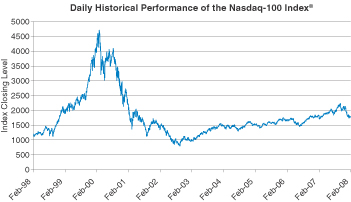
Source: Bloomberg L.P.
The NASDAQ-100 Index® closing level on February 26, 2008 was 1,791.31.
The information on the NASDAQ-100 Index®provided in this document should be read together with the discussion under the heading “The NASDAQ-100 Index®” beginning on page US-26 of underlying supplement no. 1190. Information contained in the Nasdaq website referenced above is not incorporated by reference in, and should not be considered a part of, this free writing prospectus.
9
Supplemental Plan of Distribution
We will agree to sell to UBS Financial Services Inc. and Lehman Brothers Inc. (together, the “Agents”), and the Agents will agree to purchase, all of the Notes at the price indicated on the cover of the pricing supplement, the document that will be filed pursuant to Rule 424(b) containing the final pricing terms of the Notes. UBS Financial Services Inc. may allow a concession not in excess of the underwriting discount to its affiliates.
We have agreed to indemnify the Agents against liabilities, including liabilities under the Securities Act of 1933, as amended, or to contribute to payments that the Agents may be required to make relating to these liabilities as described in the MTN prospectus supplement and the base prospectus. We have agreed that UBS Financial Services Inc. may sell all or a part of the Notes that it purchases from us to its affiliates at the price that will be indicated on the cover of the pricing supplement that will be available in connection with the sales of the Notes.
Subject to regulatory constraints, Lehman Brothers Inc. has agreed to use reasonable efforts to make a market in the Notes for so long as the Notes are outstanding.
We expect to deliver the Notes against payment on or about March 31, 2008, which is the fifth business day following the Trade Date. Under Rule 15c6-1 of the Exchange Act, trades in the secondary market generally are required to settle in three business days, unless the parties to any such trade expressly agree otherwise. Accordingly, if any purchaser wishes to trade the Notes on the Trade Date, it will be required, by virtue of the fact that the Notes initially will settle on the fifth business day following the Trade Date, to specify an alternative settlement cycle at the time of any such trade to prevent a failed settlement.
We or our affiliate will enter into swap agreements or related hedge transactions with one of our other affiliates or unaffiliated counterparties in connection with the sale of the Notes, and the Agents and/or an affiliate may earn additional income as a result of payments pursuant to the swap or related hedge transactions.
10